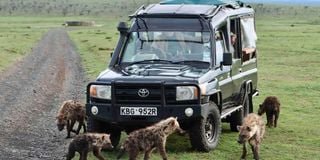The place to see all endangered species

Elephants are advised to cross two at a time because that’s all the weight the Ewaso Nyiro bridge can handle.
What you need to know:
- After a sumptuous lunch and siesta, the afternoon game drive has us crossing the bridge spanning the Ewaso Nyiro River.
- Inside the education centre, there’s more to discover including seeing the cage that Poco who we have just met, was imprisoned in for nine years.
It’s an OMG moment that within minutes of landing at Ol Pejeta, the wildlife conservancy on the equator, a cheetah struts the plains. We follow her at a respectable distance. She’s calm, she’s confident and marks her territory by peeing on the acacia trees.
Showing her picture to the guides at Ol Pejeta, Leila Amankwar, who doubles up as the guide at Ol Pejeta’s chimpanzee sanctuary, thinks it is Nyokabi, the famous cheetah named after the conservancy’s first female ranger. She had a litter of four and one of the cubs is Zawadi named after Zacharia Kipkirui Mutai, the head rhino caretaker.
Nyokabi then focuses on a herd of Grant’s gazelles and stalks – prey and predator vanish into the horizon and we continue to check in at the lodge, Sweetwaters Serena.
Now if that isn’t excitement enough, not far from her in the horizon is a pair of rhinos – our indigenous black which you can tell from the profile. Our Kenyan black rhino are browsers so they hold their heads up. It’s a calf with the mum.

Rhinos pictured by tourists in Ol Pejeta Conservancy and game park in Laikipia.
By the time we reach the lodge, we’ve seen four of the Big Five: Cheetah (can replace the leopard), elephants, rhinos both black and white, buffalos and plenty of plains game including the northern species like the Reticulated Giraffe.
Life just keeps getting better. After a sumptuous lunch and siesta, the afternoon game drive with Nathifu Abdi, the female driver-guide at Serena, has us crossing the bridge spanning the Ewaso Nyiro River, the life-lung of the arid north.
Elephants are advised to cross two at a time because that’s all the weight the bridge can handle. A pride of lions relax at the dam nearby after which we’re treated to sun-downers by the swamp teeming with elephants. It’s ethereal.
The following day, it’s to the chimpanzee’s sanctuary which is super entertaining as the apes play and squabble. These are the lucky few rescued from the evils of the illegal trade in wildlife for the pet industry.

Lion tracking in Ol Pejeta Conservancy.
Like in the case of cheetah cubs stolen from the mother, infant chimpanzees are also stolen from the mother who is most often killed by the poachers to get to the baby. Chimpanzees, our closest relatives, care for their young as we do.
Inside the education centre, there’s more to discover including seeing the cage that Poco who we have just met, was imprisoned in for nine years. Unable to stand, he arrived at the sanctuary traumatised. When the 12-year-old girl enters, she can only couch in the cage.
Read more about the chimps here https://www.olpejetaconservancy.org/wildlife/chimpanzees/meet-the-chimpanzees/ before you visit them to really understand the horrors they have been through.
We’re off to visit Baraka, the blind black rhino born in the wilds of Ol Pejeta who lost one eye after getting involved in a fight and the other due to a cataract. Now safe in his private suite, he allows us to pet him, feed him and when he’s tired of us, strolls off.

Inquisitive hyenas encircling a safari vehicle in Ol Pejeta Conservancy.
A short drive away we’re at the tombstones of the rhinos – many poached for their horn that’s actually tightly bound hair and the few who died a natural death like Morani who, like Baraka, was pretty tame.
Finally, we arrive at the equator line that marks the divide between the northern and southern hemisphere and shown a simple demo of the Coriolis effect on water and weather – it makes storms swirl clockwise in the Southern hemisphere and counterclockwise in the Northern Hemisphere.
Then it’s lunch by the busy waterhole when another pair of black rhino appears for a drink. Lunch is abandoned as everyone wants the iconic picture of the rare mega-herbivore joining us for lunch.
Read more on the exciting conservancy on https://www.olpejetaconservancy.org/. It’s 221 kilometres north of Nairobi. It is home to the last of the two northern white rhino – the mother and daughter. The subspecies is extinct in the wild.
There’s so much more to do at Ol Pejeta, from night game drives to the African wild dogs that nearly became extinct a century ago.
www.rupitheafricantrotter.com




